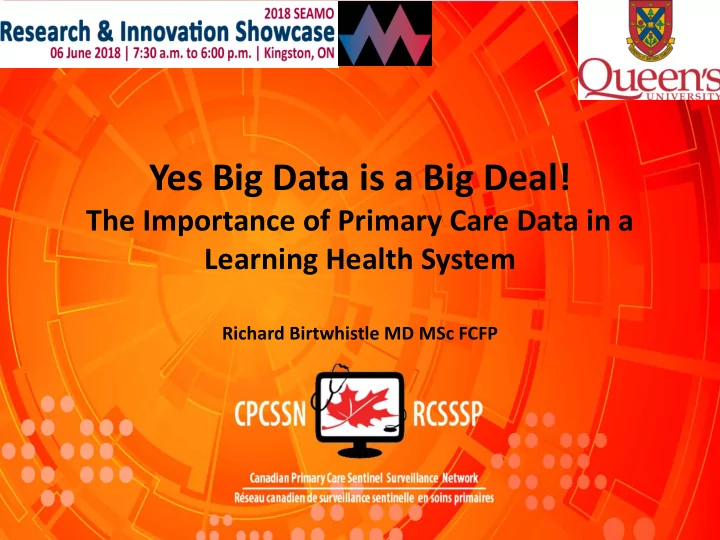

Yes Big Data is a Big Deal! The Importance of Primary Care Data in a Learning Health System Richard Birtwhistle MD MSc FCFP
Declaration I have received research funding for CPCSSN from CIHR, PHAC, Canadian Frailty Network, CIMVHR, Calian Canada, Shire Canada, Eli Lilly Canada, Merck Canada and Pfizer Canada
Objectives 1. Understand that data is fundamental to a learning health system. 2. Provide an overview of the CPCSSN. 3. Examples of CPCSSN data use for practice quality improvement, research and surveillance and health system use.
Learning Health Systems 2012 IOM Recommendations 1. Digital Infrastructure 2. Data Utility 3. Clinical Decision Aids
Primary Care 10 Building Blocks of High-Performing Primary Care T Bodenheimer et al Ann Fam Med March 2014
Finding the Missing Link for Big Biomedical Data Weber GM, Mandl KD and Kohane IS, JAMA.2014;311(24):2479-2480
Unique pan- Canadian primary care database The Canadian Primary Care Sentinel Surveillance Network: 1.8 million Canadian patients • 1300 practices • 12 PBRNs in 7 provinces, 1 territory • Some EMR data back to 2003 • Started in 2008 • $12.5M funding from PHAC • Strong partnerships with College of Family • Physicians of Canada, Queen’s and other Universities B.C. ( BCPCReN), Alberta (SAPCReN, NAPCReN), NWT, Manitoba (MaPCReN), Ontario (DELPHI, UTOPIAN, EON, MUSIC, ) , Quebec (RRSPUM) , Nova Scotia/New Brunswick (MaRNet), Newfoundland (APBRN)
CPCSSN Data 8 • Provider profile • Patient socio-demographics • Disease/ health condition • Encounter data • Risk factor data • Examination data • Medications • Laboratory data • Referral data • Procedure data
Uses of the Data
Research
Risk Ratios for VZV by select disease status Variable With Without Unadjusted Age-sex adjusted Zoster (n) Zoster (n) 95% CI 95% CI RR Lower Upper RR Lower Upper No indication of 3343 470407 Reference Reference diagnoses of interest* With Diabetes 1210 60950 2.73 2.55 2.92 1.27 1.19 1.37 With COPD 521 22546 2.87 2.57 3.21 1.24 1.10 1.39 With any 1454 73947 3.57 3.29 3.86 1.60 1.47 1.74 Neoplasm With HIV/AIDS 48 1418 6.13 4.16 9.01 4.34 2.95 6.38 * Patients who have no indication of Diabetes, COPD, Hypertension, Depression, Osteoarthritis, Dementia, Epilepsy, Parkinsonism, any Neoplasm, or HIV/AIDS.
Research
Uses of the Data Data Linkage
Data Linkage
Results Level of HbA1c and hospital and emergency room utilization Variable A1c <7 7-8 >8 Missing P value level N 5526 2662 1814 2356 Age (yr) Mean 65.7 64.7 58.1 61.0 <.001 Female % 50.1 47 45.4 50.3 <.001 Any acute % 1.9 3.1 6.0 - <.001 complication Any chronic % 2.1 3.3 3.8 - <.001 complication ER visits Mean 0.63 0.67 0.95 - <.001 Inpatient Mean 0.18 0.22 0.26 - <.001 episodes ADGs 6.39 6.15 5.98 6.35 <.001
Uses of the Data
Examples Frailty
Examples Post Traumatic Stress Disorder
Research Identification of Patients with Rare Disease in Electronic Medical Records Mucopolysaccharidosis Type II Detection by Naïve Bayes Classifier: an Example of Patient Classification for a Rare Disease Using Electronic Medical Records Authors Behrouz Ehsani-Moghaddam (PhD) 1 ,John A. Queenan (PhD) 1 , Jennifer MacKenzie (MD) 2 , Richard V. Birtwhistle (MD, MSc) 1
Uses of the Data
DPT CPCSSN Data Presentation Tool
DPT Dashboard
DPT Case Finder
Custom Searches
GIS mapping
Cautions § EMR data is difficult to work with § Need for continuous quality monitoring § Cost of data access § Data Privacy
Summary
Yes Big Data is a Big Deal!
CPCSSN Partner Universities
30
Recommend
More recommend